

How to Write A Tutorial (Also, How To Make A Daisy Chain) Now, I gotta say right off - I might be really stepping in it here: writing a tutorial on how to write a tutorial?!
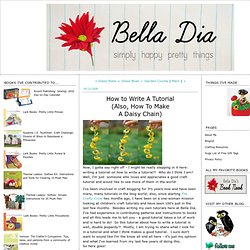
Who do I think I am? Well, I'm just someone who loves and appreciates a good craft tutorial and would like to see more of them in the world! I've been involved in craft blogging for 3½ years now and have seen many, many tutorials in the blog world; also, since starting The Crafty Crow two months ago, I have been on a one-woman mission looking at children's craft tutorials and have seen 100's just in the last few months. Trucs et Astuces pour faire un bon tutoriel... Salut à tous, Avec l'arrivée de nouveaux tutoriels participant au concours, j'ai pensé qu'il pourrait être utile de rassembler des conseils et des astuces pour les réaliser et maximiser vos chances de gagner, et de faire un tutoriel utile. 1 Au niveau de la forme 1.1 Introduire le sujet Tout d'abord, le titre doit être explicite.
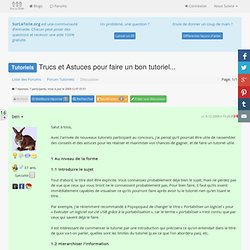
Vous connaissez probablement déjà bien le sujet, mais ne perdez pas de vue que ceux qui vous liront ne le connaissent probablement pas. Par exemple, j'ai récemment recommandé à Popopopaul de changer le titre « Portabiliser un logiciel » pour « Exécuter un logiciel sur clé USB grâce à la portabilisation », car le terme « portabiliser » n'est connu que par ceux qui savent déjà le faire.
Il est intéressant de commencer le tutoriel par une introduction qui précisera ce qu'on entendait dans le titre: de quoi va-t-on parler, quelles sont les limites du tutoriel (p.ex ce que l'on abordera pas), etc. 1.2 Hierarchiser l'information 1.3 Être clair et concis. Tutorial Writing: How to Write Tutorials that Get Accepted. When I began my tutorial website, all that I knew was that I wanted to share information with other people.

I'd never tried writing a tutorial before, so I wasn't sure how to go about it and decided that if I was going to do it, I should just do it and learn from my - inevitible - mistakes. It's been nearly 5 years since my tutorial site first opened. During that time, it's changed names once, changed focus twice, and gone from an unknown hobbyist's site to one that is featured in all the top tutorial directories and receives more than 100,000 visitors a month.
Not bad for a girl with no idea what she was starting when she started it. My story is not the norm. A good 90% of the emails I continue to receive, though, all offer up the same type of question: "Why is your work in (where ever) and I can't get them to take mine? " 8 Tips to Write a Tutorial That Gets You Noticed. One of the ways crafters and artists promote themselves and boost visibility is by sharing their skills in tutorials.

It's a great idea to post tutorials on your own blog. But writing a tutorial is a bit like writing a good recipe. You want people to end up feeling great about learning something new, rather than wasting time on a half-baked project. Tutorials should be clear, well-illustrated and tested. So, here are 8 great tips to writing tutorials! 1. Think about who you're targeting with the tutorial – are they beginners, intermediates or experts?
2. Tutorial- How to Write A Tutorial. What is a tutorial?

A tutorial is a connected series of instructions that leads the user through the key features of a software program and familiarizes him/her with all its aspects. In the process of going through the tutorial, the user learns how to use the software effectively. Why do you need tutorials in addition to the “help” section? When you have never used a piece of software before, or when clicking on “Help” is not answering your question(s), a tutorial is a good way to answer some of your questions or even help you get started. Providing a tutorial in the User Manual is highly recommended for better understanding of all software features. How To Write A Successful Tutorial. Published on Tue, Aug-23-2011 by Daniel The Internet has become an increasingly important entity and at times even indispensable.
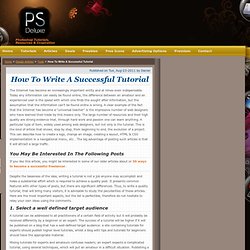
Today any information can easily be found online, the difference between an amateur and an experienced user is the speed with which one finds the sought after information, but the assumption that the information can’t be found online is wrong. A clear example of the fact that the Internet has become a “universal teacher” is the impressive number of web designers who have learned their trade by this means only. The large number of resources and their high quality are strong evidence that, through hard work and passion one can learn anything. A particular type of item, widely used among web designers, but not only is the tutorial. You May Be Interested In The Following Posts. How to write a good tutorial. In this tutorial, I am going to walk you through writing your first tutorial, and then offer some advice on what makes a good tutorial!
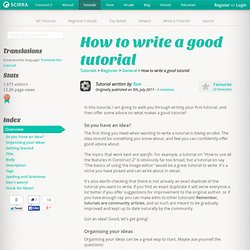
So you have an idea? The first thing you need when wanting to write a tutorial is having an idea. The idea should be something you know about, and feel you can confidently offer good advice about. The topics that work best are specific. How to write killer tutorials - Jerod Moore - Digital Architect. Writing a tutorial for the internet needs to be specific and focused on the exact activity you will be providing education on.
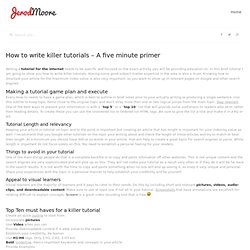
In this brief tutorial I am going to show you how to write killer tutorials. Having some good subject matter expertise in the area is also a must. Knowing how to structure your article for the maximum index value is also very important, as you want to show up in relevant pages on Google and other search engines. 11 Essential Tips to Writing the Ultimate Tutorial. By Daniel Scocco This is a guest post by Quan Quach.

If you would like to guest author on Daily Blog Tips just send me an email through the Contact Form. Why Write a Tutorial? Creating value-packed content is key in attracting and retaining readership. One of the best ways to create such value-packed content is to write an informative tutorial or guide on a subject that is sorely lacking one. Tutorials are a great source of traffic that is maintained over time. Take for example, Caroline MiddleBrook’s Twitter Guide or Skelliewag’s Flickr Guide. Piecing together the Tutorial 1.
Obviously, it helps if there is a need or demand for said tutorial. 2. 3. 4. 5. 6. 7. 8. 9. 10. How to Write a Tutorial: 10 Steps.